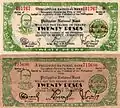Emergency circulating notes
Emergency circulating notes were currency printed by the Philippine Commonwealth Government in exile during World War II. These "guerrilla pesos" were printed by local government units and banks using crude inks and materials. Due to the inferior quality of these bills, they were easily mutilated.

| Emergency circulating notes | |
|---|---|
| Denominations | |
| Subunit | |
| 100 | Centavos |
| Plural | The language(s) of this currency do(es) not have a morphological plural distinction. |
| Symbol | ₱ |
| Banknotes | Various denominations (from the Philippine National Bank and the Provincial and Municipal Governments of the Commonwealth of the Philippines) |
| Demographics | |
| User(s) | |
| Issuance | |
| Central bank | Philippine National Bank Provincial and Municipal Governments of the Commonwealth of the Philippines |
This infobox shows the latest status before this currency was rendered obsolete. | |
The Japanese-sponsored Second Philippine Republic under President José P. Laurel outlawed possession of guerrilla currency and declared a monopoly on the issuance of money and anyone found to possess guerrilla notes could be arrested or even executed.
Types
Apayao

Apayao was one of the sub-provinces which comprised the Mountain Province during World War II. In the remote sub-province of Apayao, Deputy Governor Milton Ayochok assumed, the authority granted by President Manuel L. Quezon to print emergency currency. On September 11, 1942, the Apayao Provincial Board authorized the printing of currency to provide for the budget for fiscal year 1942-1943. A Currency Committee was formed composed of Deputy Governor Ayochok as Chairman, with Deputy Treasurer M. Medina and Deputy Auditor F.A. Enciso as members.
First Issue (1942)
The First Issue was printed from hand-engraved plates. Records state that a total of ₱105,495 was issued. Printing probably took place at Kabugao, its provincial capital in conjunction with the printing of the Cagayan fourth issue.
Second Issue (1943)
The Second Issue was produced by mimeograph. Official records of this issue were captured by the Japanese. Known serial numbers would indicate that this issue equaled or possibly exceeded the previous issue and was probably intended for the fiscal year 1943–1944 budget.
Bohol
On May 22, 1942, Japanese occupation forces established garrisons at Tagbilaran, the provincial capital, and Guindulman where they operated manganese mines. On January 9, 1943, resistance officers and provincial officials who had not surrendered established a "free" government with Conrado D. Marapao as governor. Eventually its jurisdiction was established over 34 of the 35 municipalities. Just prior to the surrender, President Quezon had authorized Bohol to issue ₱150,000 in emergency currency. This authority was the basis for printing currency to finance the free government and the resistance force. The Currency Board consisted of Provincial Auditor Dalmatio Ramos as Chairman, with Provincial Fiscal José C. Borromeo and Acting Provincial Treasurer Doreteo Toledo as members.
In June 1943, radio contact was established with President Quezon, who authorised an additional ₱200,000. In September, President Quezon authorised an additional ₱1 million. The printing took place in the town of Carmen. Notes were printed in black on manila paper of varying thickness, except for a few hundred notes on white paper. Serial numbers were applied in two different styles of type.
Gallery
 1-peso Negros Occidental denomination
1-peso Negros Occidental denomination 1-peso Negros Oriental denomination
1-peso Negros Oriental denomination 10-peso Note of the Mindanao Emergency Currency Board
10-peso Note of the Mindanao Emergency Currency Board 20-peso Philippine National Bank Iloilo denomination and Roosevelt counterfeit
20-peso Philippine National Bank Iloilo denomination and Roosevelt counterfeit
The portrait printed on the Negros Occidental bill is that of Quezon, who was the first president of the Commonwealth of the Philippines under U.S. sovereignty.